I
have always wondered why this 3x3 pattern appears on bronze bells from over
2,000 years ago. These bells were known
to be used for ceremonial purposes and were played in the royal court. Examining the relationship of the Luo Shu, He Tu, and number
manipulation may lead to some interesting results pertaining to music.
Upon close examination of the 9x9 magic square in the Luo Shu format, it can be demonstrated that the He Tu pattern presents itself.
A) Formula for 3x3 magic square which can be expanded to larger magic squares.1
Upon close examination of the 9x9 magic square in the Luo Shu format, it can be demonstrated that the He Tu pattern presents itself.
First, a review of the 3x3 magic square also known as the
Luo Shu. It is important to realize that the 3x3 magic square has a formula:
| 3x3 Magic Square | FORMULA | |||||
| 4 | 9 | 1 | Y + 1 |
X2
|
Y - X | |
| 3 | 5 | 7 | X | Y | 2Y - X | |
| 8 | 1 | 6 | Y + X | 1 | Y - 1 | |
A) Formula for 3x3 magic square which can be expanded to larger magic squares.1
This relationship can be expanded into larger order magic
squares that all feature a Pythagorean triplet of numbers at the heart of every
magic square. In addition, the numbers of the calendar are featured in the
13x13 and 27x27 magic squares. For these reasons, the Luo Shu was
considered an ideal model of time and space.
[For convenience, Y = (X2
+ 1) ÷
2].
(Note: The Chinese translation of Luo Shu and the He Tu deserves a
moment of reflection. He Tu translates as Yellow River Chart indicating a
singular image. Luo Shu translates to Luo River Document or Luo River Writing
possibly indicating multiple images. It is best to think of the Luo Shu as a set of magic squares based on a
formula that describes the simplest magic square, the 3x3, but can be expanded
to include larger order magic squares that have relevance to the Chinese
numerology system.
The Luo Shu is from Heaven
In a perfect world, the music of the royal court would be composed by Heaven and not by humankind. Music was considered to be a gift from Heaven, as are numbers and the math that follows.
The Luo Shu is from Heaven
In a perfect world, the music of the royal court would be composed by Heaven and not by humankind. Music was considered to be a gift from Heaven, as are numbers and the math that follows.
The early Chinese placed a sacred bestowment on all instruments
that connected civilization with Heaven. Astronomical instruments, musical
instruments, and mathematical tools such as the carpenters’ square and numbers
were entities that allowed humankind to connect with Heaven. Some of these
astronomical instruments (the bi disc and cong tube) became relics used
in ceremonies, other tools such as the carpenters’ square became iconic
symbols. These religious relics and
iconic symbols could find their way into the royal tomb to assist in the
emperor’s journey thru the underworld.
The early Chinese believed that to evolve and prosper, the
sacred rules of Heaven must be followed. Within the math of numbers (i.e. the
language of Heaven) was a plan; society could apply mathematics and succeed.
This so called “plan from Heaven” comes from the Hong Fan, a legendary
Chinese belief system that claims the Luo Shu Magic Square contains the “plan
for humankind”. Regardless of Chinese
mythology, it is clear that the “set” of magic squares in the Luo Shu format
are not man-made, these mathematical relationships must be discovered by man
and therefore are constructed by “nature”.
Hence, magic squares were part of an armamentarium of important
tools (or instruments) that helped guide the early Chinese as magic squares (in
the Luo Shu format) were a major influence on: temple design, pictograms of the Chinese
language, art, and even tomb and city design.2 This is consistent with early Chinese classification
systems that depend on centrality, order, and symmetry. As the magic square was the perfect model for
these requirements, the early Chinese, especially the royal court, invested
heavily (labor, materials, money) by incorporating the esoteric, yet
mathematical, philosophy of the Luo Shu into society over a period of 2,000
years (1,100BC to 1,000AD). Although the Luo Shu was not included in the Yi
Jing until about 1,000AD, there can be no doubt that the legacy of the Luo
Shu had begun over 2,000 years prior to this inclusion!
THE 9X9 MAGIC SQUARE AND THE HE TU
| |||||||||||||||||||||||||||||||||||||||||||||||||||||||||||||||||||||||||||||||||||||||||||||||||||||||||||||||||||||||||||||||||||||||||||||||||||||||||||||||||||||||||||||||||||||||||||||||||||||||||||||||||||||||||||||||||||||||||||||||||||||
B) Here one one can see the He Tu pattern emerge when the numbers are reduced to their Pythagorean root number.
In order to apply musical notes to this arrangement of numbers it is useful to know that in the ancient Chinese musical gamut, 5 notes made up the pentatonic scale. The Pythagorean root numbers will be re-written in Base 5 notation to match the pentatonic scale:
Translating to Base 5 notation
|
||||||||
1
|
11
|
2
|
12
|
3
|
13
|
4
|
14
|
5
|
11
|
2
|
12
|
3
|
13
|
4
|
14
|
5
|
1
|
2
|
12
|
3
|
13
|
4
|
14
|
5
|
1
|
11
|
12
|
3
|
13
|
4
|
14
|
5
|
1
|
11
|
2
|
3
|
13
|
4
|
14
|
5
|
1
|
11
|
2
|
12
|
13
|
4
|
14
|
5
|
1
|
11
|
2
|
12
|
3
|
4
|
14
|
5
|
1
|
11
|
2
|
12
|
3
|
13
|
14
|
5
|
1
|
11
|
2
|
12
|
3
|
13
|
4
|
5
|
1
|
11
|
2
|
12
|
3
|
13
|
4
|
14
|
C) The Pythagorean root numbers translated to Base 5 notation
Note C is selected as the middle note of the pentatonic
scale, note C is assigned to the number five, and with that the rest of the
notes (A, B, E, and G) fall into place. The six is translated to eleven in base
five notation and refers to the A note of the second ascending scale and is
noted as A(2).
NUMBERS IN
|
NUMBERS IN
|
NOTE
|
BASE 10 NOTATION
|
BASE 5 NOTATION
|
|
1, 6
|
1, 11
|
A, A(2)
|
2, 7
|
2, 12
|
B, B(2)
|
3, 8
|
3, 13
|
E, E(2)
|
4, 9
|
4, 14
|
G, G(2)
|
5
|
5
|
C
|
D) The numbers have been translated
into Base 5 notation and assigned musical notes in the Pentatonic scale.
Sequence of notes
|
FIRST STANZA
|
5, 1, 6 = C,
A, A(2)
|
5, 7, 2 = C,
B(2), B
|
5, 3, 8 = C,
E, E(2)
|
5, 9, 4 = C, G(2),
G
|
The wan character, 卍,has
been associated with the He Tu and the Luo Shu.
Berglund maintains that the
symbol 卍 was based on pairs of numbers of
the Luo Shu Magic Square representing the five elements and, by extension, the
universe.3 (Aihe Wang, A.C.
Graham, and Sarah Allan all support the Si Fang/Wuxing philosophy
involving the Luo Shu and He Tu).4 If this is true, then the 卍 comes
from the He Tu numerical pairs being emphasized on the Luo Shu 3x3 grid of
numbers, creating the pairs of numbers associated with the middle number, 5.
This gives the symbol 卍 mathematical relevance and
corresponds to several important Chinese philosophical concepts: the four
cardinal directions, Heaven and earth, the five elements, the axis mundi
or cosmic center, the carpenters’ square, the right angle triangle theorem, the
gnomon and time keeping. As this pattern (1,6; 2,7; 3,8;
4,9; 5) appears in the 9x9 M.S., then there can be no doubt that the He Tu
pattern is related to, and even comes from, the 9x9 M.S. (see table B above). The Luo Shu and He Tu were
the two main mathematical philosophies by which everything in the
YinYang/Wuxing compendium was connected.
Therefore, are the He Tu and Luo Shu the basis of early Chinese
ceremonial music? If a musical composition were to be based on the mathematical
patterns of the Luo Shu and He Tu, then this music could be hypothesized to be
“from Heaven” and be consistent with YinYang/Wuxing philosophies. In
other words, music derived from the mathematics of the Luo Shu would be ideal
for sacred and ceremonial music as well as music for political purposes.
Footnotes and References
1. 1. Dickter,
Robert, Number Time Archetype, California (2014)
2. 2. Schinz,
Alfred, The Magic Square, Great Britain (1996)
3. 3. Berglund,
Lars, The Secret of the Luo Shu, Sweden (1990)
4. Wang, A.E., Cosmology and Political Culture in Early China, Cambridge (2000)
4. Wang, A.E., Cosmology and Political Culture in Early China, Cambridge (2000)























